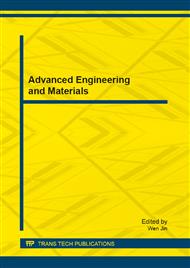[1]
A. Inoue, Amorphous, nanoquasicrystalline and nanocrystalline alloys in Al-based systems, Prog. Mater. Sci., 43 (1998) 365-520.
DOI: 10.1016/s0079-6425(98)00005-x
Google Scholar
[2]
Y.H. Kim, A. Inoue, T. Masumoto, Ultrahigh Tensile Strengths Of Al88y2ni9mn1 Or Al88y2ni9fe1 Amorphous-Alloys Containing Finely Dispersed Fcc-Al Particles, Mater. Trans. JIM, 31 (1990) 747-749.
DOI: 10.2320/matertrans1989.31.747
Google Scholar
[3]
H. Chen, Y. He, G.J. Shiflet, S.J. Poon, Mechanical-Properties of Partially Crystallized Aluminum Based Metallic Glasses, Scr. Metall. Mater., 25 (1991) 1421-1424.
DOI: 10.1016/0956-716x(91)90426-2
Google Scholar
[4]
B.J. Yang, J.H. Yao, J. Zhang, H.W. Yang, J.Q. Wang, E. Ma, Al-rich bulk metallic glasses with plasticity and ultrahigh specific strength, Scr. Mater., 61 (2009) 423-426.
DOI: 10.1016/j.scriptamat.2009.04.035
Google Scholar
[5]
A. Inoue, K. Ohtera, A.P. Tsai, H. Kimura, T. Masumoto, GLASS-TRANSITION BEHAVIOR OF AL-Y-NI AND AL-CE-NI AMORPHOUS-ALLOYS, Jpn. J. Appl. Phys. 2, 27 (1988) L1579-L1582.
DOI: 10.1143/jjap.27.l1579
Google Scholar
[6]
H.W. Yang, P. Dong, J.Q. Wang, Y. Li, Glass formability and structural stability of Al-based alloy systems, Mater. Sci. Eng. A, 449-451 (2007) 273-276.
DOI: 10.1016/j.msea.2006.02.368
Google Scholar
[7]
B. Liu, L. Liu, Improvement of corrosion resistance of Cu-based bulk metallic glasses by the microalloying of Mo, Intermetallics, 15 (2007) 679-682.
DOI: 10.1016/j.intermet.2006.10.039
Google Scholar
[8]
L. He, J. Sun, Effect of microalloying on glass-forming ability and crystallization kinetics of Zr52. 5Cu17. 9Ni14. 6Al10Ti5 alloy, Scr. Mater., 54 (2006) 1081-1085.
DOI: 10.1016/j.scriptamat.2005.12.004
Google Scholar
[9]
Z.P. Lu, C.T. Liu, Role of minor alloying additions in formation of bulk metallic glasses: A review, J. Mater. Sci., 39 (2004) 3965-3974.
DOI: 10.1023/b:jmsc.0000031478.73621.64
Google Scholar
[10]
H. Fu, M. Zou, Y. Mudryk, V.K. Pecharsky, K.A. Gschneidner, Enhancement of the glass-forming ability by Zr microalloying and its influence on the magnetocaloric properties of bulk amorphous Gd-Co-Al, J. Appl. Phys., 108 (2010).
DOI: 10.1063/1.3481923
Google Scholar
[11]
P.F. Sha, Z. Qi, Z.H. Zhang, Effect of Ag or Pd additions on the microstructure, crystallization and thermal stability of Al-Ni-Ce amorphous alloys, Intermetallics, 18 (2010) 1699-1706.
DOI: 10.1016/j.intermet.2010.03.035
Google Scholar
[12]
X.P. Nie, X.H. Yang, J.Z. Jiang, Ti microalloying effect on corrosion resistance and thermal stability of CuZr-based bulk metallic glasses, J. Alloy Compd., 481 (2009) 498-502.
DOI: 10.1016/j.jallcom.2009.03.022
Google Scholar
[13]
J. Pan, L. Liu, K.C. Chan, Enhanced plasticity by phase separation in CuZrAl bulk metallic glass with micro-addition of Fe, Scr. Mater., 60 (2009) 822-825.
DOI: 10.1016/j.scriptamat.2009.01.032
Google Scholar
[14]
G.J. Fan, L.F. Fu, D.C. Qiao, H. Choo, P.K. Liaw, N.D. Browning, J.F. Loffler, Effect of microalloying on the glass-forming ability of Cu60Zr30Ti10 bulk metallic glass, J. Non-Cryst. Solids, 353 (2007) 4218-4222.
DOI: 10.1016/j.jnoncrysol.2007.08.057
Google Scholar
[15]
K.F. Kelton, Influence of microalloying on glass formation and crystallization, J. Alloy Compd., 434 (2007) 115-118.
Google Scholar
[16]
A. Mukhopadhyay, K.E. Spence, L.Q. Xing, W.E. Buhro, K.F. Kelton, An Al-rich metallic glass with a large supercooled liquid region, Philos. Mag., 87 (2007) 281-290.
DOI: 10.1080/14786430600953798
Google Scholar
[17]
H.W. Yang, W.P. Tong, X. Zhao, L. Zuo, J.Q. Wang, Identificaiton of the true glass transitions in an Al-based metallic glass using temperature modulated differential scanning calorimetry, J. Alloy Compd., 473 (2009) 347-350.
DOI: 10.1016/j.jallcom.2008.05.086
Google Scholar
[18]
Y. Li, S.C. Ng, Z.P. Lu, Y.P. Feng, K. Lu, Separation of glass transition and crystallization in metallic glasses by temperature-modulated differential scanning calorimetry, Philos. Mag. Lett., 78 (1998) 213-220.
DOI: 10.1080/095008398177959
Google Scholar


